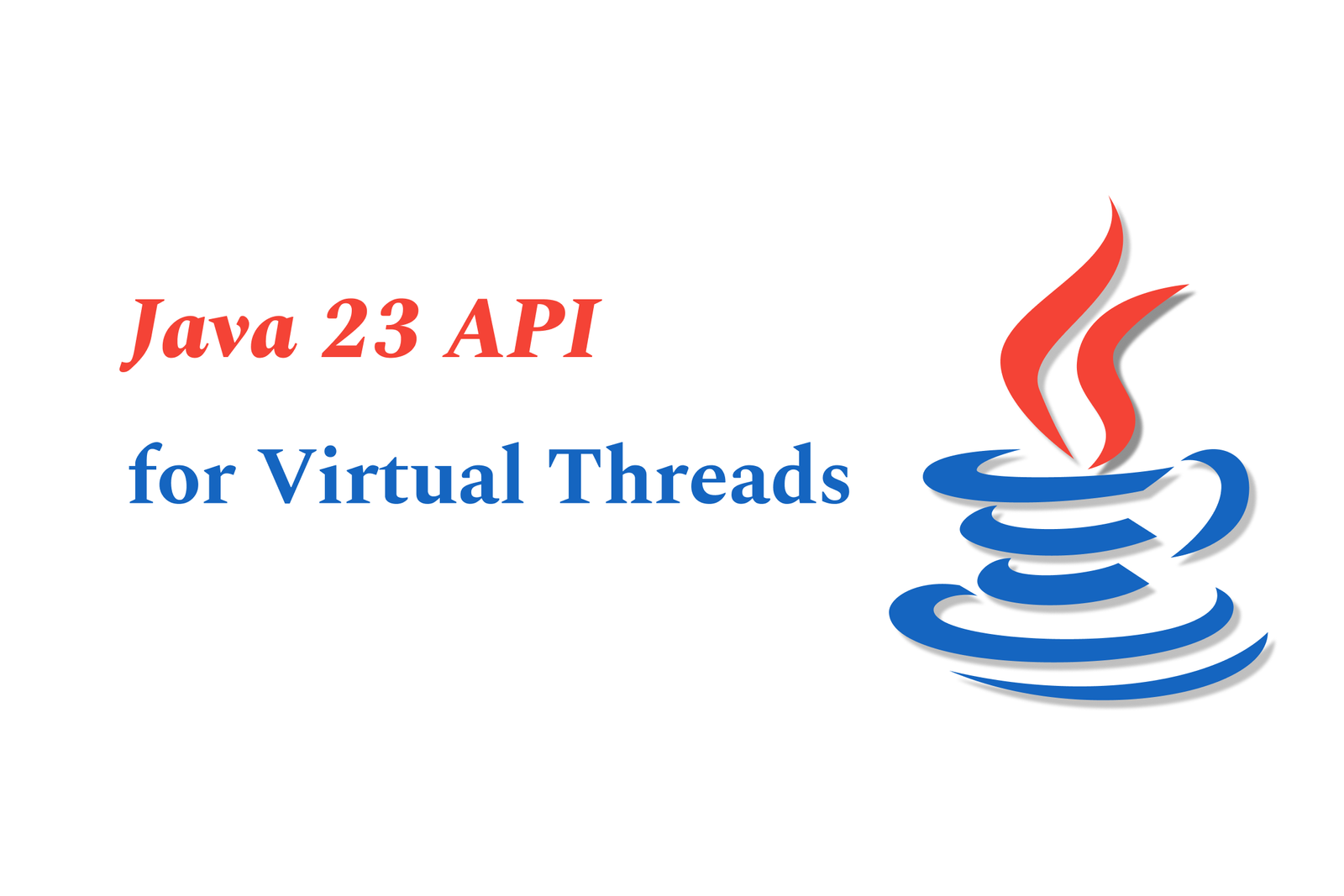Java 23 API for virtual threads
Java 23 API for Virtual Threads introduces lightweight, JVM-managed threads that enable massive concurrency by efficiently handling millions of blocking tasks with minimal resource use. They coexist with platform threads, improving scalability for I/O-bound applications.
Java 23 API for Virtual Threads
1 ) Introduction to Java Threads
Java provides two main categories of threads: platform threads and virtual threads. Both are instances of `java.lang.Thread` and represent units of concurrent execution within a JVM.
2 ) Platform Threads
Platform threads are closely tied to underlying operating system (OS) threads, mapping 1:1 to the OS.
They typically have a large stack and consume more system resources.
Suitable for all types of tasks but limited due to OS thread constraints.
Have associated properties like priority, daemon status, and belong to thread groups.
3 ) Virtual Threads Overview
Virtual threads are lightweight threads managed by the Java runtime rather than the OS.
They can scale to millions, as they use a limited set of OS threads (carrier threads) on which virtual threads are scheduled.
Virtual threads can be suspended when blocking (e.g., on I/O), freeing the OS thread for other tasks, improving scalability.
Intended primarily for tasks spending most time in blocked states, such as I/O operations—not ideal for CPU intensive tasks.
Maintain thread local and inheritable thread local variables, but usage should be cautious due to large scalability potential.
4 ) Benefits of Virtual Threads
Enable high throughput concurrent applications by supporting vast numbers of concurrent tasks efficiently.
Not designed to make threads run faster, but to increase scalability and throughput without increasing resource consumption proportionally.
5 ) Creating and Managing Virtual Threads
Java API includes constructors and `Thread.Builder` for both platform and virtual threads.
The `java.util.concurrent.Executors` class offers convenient methods to create ExecutorServices that use virtual threads.
Virtual threads can be created and started just like platform threads, with the runtime handling scheduling and suspension.
6 ) Iteration and Management of Threads Including Virtual Threads
There is currently no standard public API for iterating all threads (both platform and virtual) comprehensively.
Internal APIs like `jdk.internal.vm.ThreadContainer` provide access but require special JVM flags and are not intended for general use.
Design patterns such as visitor, composite, and facade can help manage and traverse thread hierarchies, including both thread types.
7 ) Adoption Considerations and Debugging
Virtual threads integrate naturally with existing Java concurrency constructs but require awareness of their lifecycle and resource management differences.
Debugging virtual threads may differ due to their lightweight scheduling on carrier threads.
Adoption benefits mature frameworks by potentially improving scalability and ease of high concurrency application development.
8 ) Virtual Threads and Kotlin Coroutines
Kotlin coroutines and Java virtual threads address concurrency differently and have nuanced interoperability challenges.
Kotlin coroutines avoid context switching via custom schedulers, whereas virtual threads rely on JVM managed scheduling.
Some solutions exist for running Kotlin coroutines atop virtual threads, offering performance benefits, but complete integration is complex.
Handling context propagation (ThreadLocals, scoped values) across Java virtual threads and Kotlin coroutines can be challenging.
Summary
The Java 23 API for virtual threads introduces a lightweight threading model that dramatically improves scalability for I/O bound concurrent applications. Virtual threads are designed to coexist with platform threads, providing developers with flexible means of handling massive concurrency with less resource overhead. While tools for thread management and debugging continue to evolve, virtual threads represent a significant step forward in Java's concurrency capabilities. Integration with other concurrency models like Kotlin coroutines presents ongoing opportunities and challenges in mixed language environments.
https://justacademy.in/news-detail/apple-swift-6.0-released-with-major-changes
https://justacademy.in/news-detail/flutter-forward-2025-recap
https://justacademy.in/news-detail/best-flutter-practices-every-developer-should-follow
https://justacademy.in/news-detail/top-flutter-packages-to-use-in-2025
https://justacademy.in/news-detail/top-swiftui-design-trends-for-2025
Related Posts
In 2025, top Angular libraries offer modern, feature-rich components and tools for building dynamic web apps. From powerful data grids to low-code platforms like UI Bakery, these libraries enhance development speed, UI design, and scalability, making them essential for Angular developers.
Migrating from AngularJS to Angular 17 involves gradually upgrading your app by running both frameworks together using tools like ngUpgrade, rewriting components in TypeScript, and adopting Angular’s modern architecture to enhance performance, maintainability, and long-term support.
Angular state management tools help organize and handle app data efficiently, improving scalability and maintainability. Popular options include NgRx for robust, RxJS-based patterns, and newer Signal Store solutions that offer simpler, reactive approaches integrated tightly with Angular’s latest features.
RxJS in Angular empowers developers to manage asynchronous data streams with powerful operators like `forkJoin`, `combineLatest`, and `zip`. Mastering these key operators in 2025 is essential for building efficient, reactive applications that handle complex event sequences seamlessly.
Angular performance optimization in 2025 focuses on improving app speed and responsiveness by using techniques like OnPush change detection, lazy loading, efficient data caching, and AOT compilation. These practices reduce load times, enhance user experience, and ensure scalable, fast Angular applications.
In 2025, Angular remains preferred for large-scale, enterprise apps with its robust, all-in-one framework, while Vue attracts developers seeking simplicity and fast development for smaller projects. Both frameworks excel, with choice driven by project needs and team expertise.
Angular Signals are a new reactive primitive in Angular 16 that enable fine-grained, efficient change detection by automatically tracking dependencies and updating only affected parts of the UI. They simplify state management and boost app performance, revolutionizing Angular's reactivity model.
Angular interview questions to prepare in 2025 focus on core concepts like components, directives, data binding, routing, and dependency injection, along with TypeScript mastery and latest Angular features to ensure strong practical knowledge for building scalable, efficient web applications.
AngularJS reached its official end of support in January 2022, meaning no further updates or security patches. To ensure app security and performance, developers should consider migrating to modern Angular versions or seek third-party long-term support options if immediate migration isn’t possible.
The Angular Roadmap 2025 highlights upcoming features focused on improving developer experience and performance, including zoneless Angular, Signals integration, enhanced Forms, async data handling, improved HMR, and expanded Angular Material/CDK enhancements, driving modern, efficient web app development.










